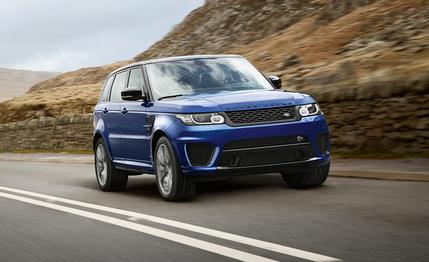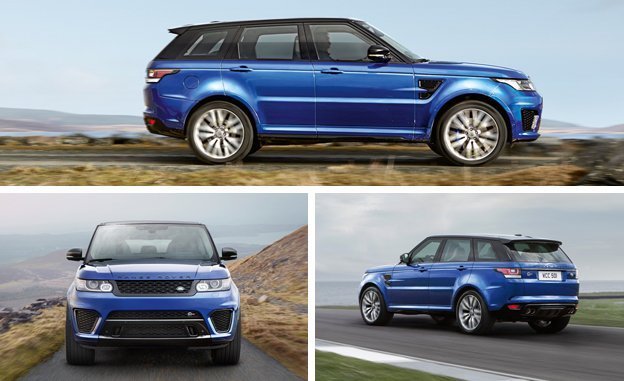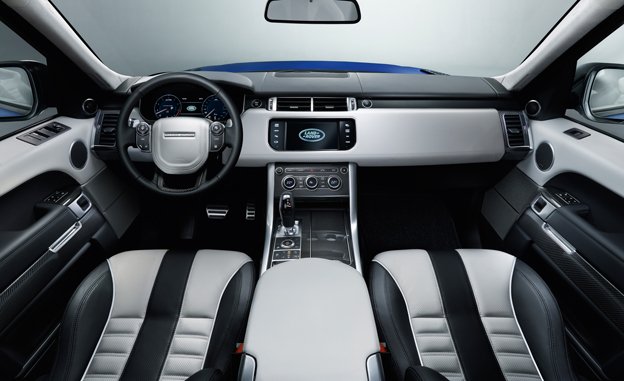
 First Drive Review
First Drive Review
The Range Rover Sport SVR is not the world’s fastest SUV. Nope, it’s the second-quickest—and that’s if you share the belief of much of the auto industry that a lap of a rarely raced German circuit remains the ultimate arbiter of performance. Land Rover says the SVR can lap the Nürburgring Nordschliefe in 8:14—putting it in a league with pretty serious sports cars from a decade ago—but that’s a yawning 15 seconds shy of the time Porsche claims for the new Cayenne Turbo S. And with that single damning statistic Land Rover should hoist the white flag and abandon the whole project, the engineering team writing formal letters of apology before heading out into the blizzard to do the decent thing.
Of course not. If you can think of a less appropriate way to assess the talent of an SUV than the time it takes to complete a cycle of the ’Ring, then we’d love to hear it. The SVR might not be the outright fastest, but this 162-mph leviathan will be fast enough for almost anybody. And after spending a week with one, we can report that its neatest trick is the way it combines the performance of a genuine sports car with manners that are nearly as urbane and sophisticated as those of the standard Range Rover Sport.
The SVR is the first performance model from JLR’s recently launched Special Vehicle Operations division, and as such we should see it as the equivalent of something like the BMW X6 M and the Mercedes-AMG GLE63. Other Jaguar and Land Rover SVR variants will follow it, and we’re promised that each will be the ultimate performance incarnation of that model. In other words, no headroom is being left for a harder-core “plus” version—this is as good as it will get.


The basics are all familiar, with many of the changes that make the SVR coming from software tuning rather than new hardware. Power comes, unsurprisingly, from JLR’s 5.0-liter supercharged V-8, here in 550-hp tune. That’s 40 more than the standard V-8–powered Range Rover Sport Supercharged, and it’s accompanied by 502 lb-ft of torque. The output is shuffled through the same eight-speed automatic gearbox of the regular Sport, but the programming is tweaked to deliver upshifts that are 50 percent quicker. The throttle is also automatically blipped during downshifts to smooth out gearchanges. The rear differential locks more aggressively than in the standard car and produces a more pronounced torque-vectoring effect. The engine is basically the same as the one you’ll find in the Jaguar F-type R and exhales through a similarly aggressive, switchable sports exhaust system that, in the SVR’s Dynamic mode, is pretty much audible from space.
Straight-line performance is startling, in much the way a whale falling through the roof would be. At low speeds, the powertrain is smooth and refined, but the beast within lurks close to the surface. Go beyond the top inch or so of throttle-pedal travel and the V-8 turns snarly and starts to pull harder. And, as your right foot moves downward, the engine pulls harder still—by the time your foot is against the firewall, the SVR is doing a good impression of a racing speedboat with a similar open-pipe soundtrack and hull-up sensation. Our 4.4-second zero-to-60-mph estimate is ridiculously quick, but even that downplays how the SVR feels when unleashed, the sensation of unstoppable acceleration aided by the transmission’s practically seamless shifting.
Cornering is equally impressive, with the SVR showing a genuine enthusiasm for changing direction. Land Rover hasn’t been able to do much to alter the Range Rover Sport’s mass or center of gravity—the SVR is a claimed 55 pounds heavier than the regular V-8 ute and tips the scales at well over 5000 pounds. Despite that, it does a remarkable job of hiding its size when driven hard over a demanding road. The car we drove was fitted with optional 22-inch wheels (21s will be standard) wearing gargantuan 295/40R-22 Continental ContiSportContact tires. These generate serious grip, even on the sort of sharp, low-speed corners that normally reduce even the sportiest of SUVs to grotesque understeer, and the steering is both accurate and well weighted. The aggressive torque-vectoring system can be felt working on longer corners, with power sent to the outside rear wheel to help the SVR to turn, although backing off the throttle in the middle of a bend means the assistance goes away and the beast feels as if it’s running wide.


Despite the hype, the SVR isn’t a sports car. That Nürburgring lap time is a triumph of power, adhesion, and the efficiency of the vast Brembo brakes; hard cornering still produces body roll and uncomfortable noises from any passengers you happen to have onboard. But the SVR is also talented at not going quickly, with the air-sprung suspension giving a comfortable ride over practically every surface. It’s marginally firmer than the standard Range Rover Sport, having modified pistons in the air springs, unique settings for the adaptive dampers, and stiffer bushings. But it’s not harsh or overly firm. Indeed, apart from the need to find the extra $30K to buy one, it’s not immediately clear what you lose by picking the SVR over the standard V-8. It can even deliver the same off-road performance—provided you swap out the tires—complete with a 33-inch wading depth and the continued presence of a low-range transmission mode for proper rock-scrambling. The question of whether you’d want to risk damaging those natty aluminum rims with a trip into the wilderness is a different matter.
Our only real complaint is with the cabin, which, apart from the unlikely sight of racing-style bucket seats, feels pretty much identical to that of the standard Range Rover Sport. If discretion is the better part of valor then it’s very brave; it’s also very dark, trimmed with carbon fiber and black microsuede. As with other JLR products, the touch-screen display feels about five years off the pace, being slow to react and with slightly blocky graphics. But these are minor issues. The Range Rover Sport SVR isn’t the fastest performance SUV, but it could be the best one to actually live with.